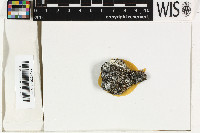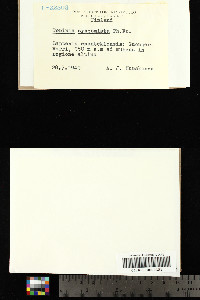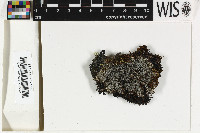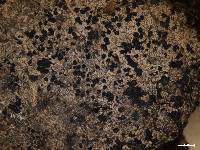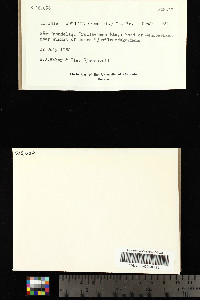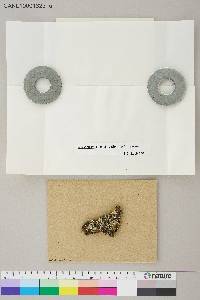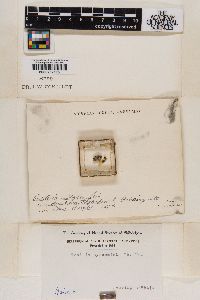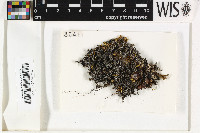
- Home
- Search
- Images
- Species Checklists
- US States: O-Z >
- US National Parks
- Central America
- South America
- US National Parks
- Southern Subpolar Region
|
Bilimbia lobulata (Sommerf.) Hafellner & Coppins
 (redirected from: Mycobilimbia lobulata (Sommerf.) Hafellner) (redirected from: Mycobilimbia lobulata (Sommerf.) Hafellner) |
|
|
Family: Ramalinaceae
[Bilimbia leucophaea A.L. Sm., moreBilimbia leucophaea var. leucophaea A.L. Sm., Bilimbia leucophaea var. montana (Nyl.) A.L. Sm., Bilimbia leucophaea var. perpallescens (Nyl.) A.L. Sm., Bilimbia syncomista (Flörke) Körb., Bilimbia syncomista f. granulosa Norman, Bilimbia syncomista f. syncomista (Fr.) Körb., Bilimbia syncomista var. diluta Norman, Bilimbia syncomista var. syncomista (Fr.) Körb., Catinaria montana (Nyl.) Vain., Lecidea lobulata Sommerf., Lecidea milliaria var. montana (Nyl.) Leight., Lecidea sabuletorum var. syncomista Flörke, Lecidea syncomista (Flörke) Nyl., Lecidea syncomista f. perpallescens Nyl., Lecidea syncomista f. syncomista (Flörke) Nyl., Lecidea syncomista var. montana (Nyl.) Nyl., Lecidea syncomista var. perpallescens (Nyl.) Nyl., Lecidea syncomista var. syncomista (Flörke) Nyl., Lecidea vernalis var. montana Nyl., Mycobilimbia lobulata (Sommerf.) Hafellner, Myxobilimbia lobulata (Sommerf.) Hafellner, Psora syncomista (Flörke) Boistel, Thalloidima conglomerans Müll. Arg., Thalloidima syncomistum (Flörke) Vain., Thalloidima syncomistum f. montanum (Nyl.) Szatala, Thalloidima syncomistum f. syncomistum (Flörke) Vain., Toninia conglomerans (Müll. Arg.) Zahlbr., Toninia lobulata (Sommerf.) Lynge, Toninia lobulata var. lobulata (Sommerf.) Lynge, Toninia lobulata var. theobaldii (Körb.) Lynge, Toninia syncomista (Flörke) Th. Fr., Toninia syncomista f. montana (Nyl.) H. Olivier, Toninia syncomista f. perpallescens (Nyl.) Zahlbr., Toninia syncomista f. syncomista (Flörke) Th. Fr., Toninia syncomista var. perpallescens (Nyl.) Walt. Watson, Toninia syncomista var. syncomista (Flörke) Th. Fr., Weitenwebera syncomista (Flörke) Poetsch] |
Thallus squamulose; squamules dull grey-green to grey-brown, typically rather paler at the margin, 0·2–0·6 mm wide, densely imbricate, sometimes becoming fused, with margin crenulate to lobulate; photobiont cells very variable, irregularly globose to broadly ellipsoid, 8–22 X 6–14 μm. Apothecia 0·25–1·0 mm wide, scattered or contiguous and becoming fused; disc brown at first, soon brown-black to black, plane to markedly convex and rather lumpy and uneven; margin concolorous with the disc, very thin, soon excluded, in section 40–60 μm thick, pale reddish brown, N+ reddish, +/- unchanged in K, composed of radiating hyphae. Hypothecium dark reddish brown, N+ reddish, unchanged in K. Hymenium colourless, with a rather incomplete grey-green, K-, N+ reddish epithecium; paraphyses simple, straight, rather robust, to 2·5 μm thick, with greyish, somewhat moniliform apices to 3·5 μm wide. Ascospores (0–)2–3-septate, 15·0–24·0 X 5·0–7·5 μm, broadly fusiform to ellipsoid, sometimes with acute, rather attenuated apices; perispore uneven, distinct in water, disappearing in K or N. Pycnidia not seen. Chemistry. No substances detectable by thin-layer chromatography. Remarks. The above description is based on the single Tasmanian specimen studied; additional descriptions of this species are provided by Timdal & James (1992) and Thomson (1997). The combination of a squamulose thallus, dark, lecideine apothecia and septate ascospores with a distinct, gelatinous perispore are diagnostic for this species. No confusing species are known from the study area. Habitat and distribution.This species is recorded here for Tasmania for the first time. McCarthy (2003) also records it for Victoria, Australia. The Tasmanian specimen grew on soil in crevices of large limestone outcrops in a high altitude grassland, a habitat consistent with its distribution in the Northern Hemisphere where it is widespread at temperate latitudes. Thompson, J., 1997. American Arctic Lichens: The Microlichens. Thallus squamulose, the squamules to 1.5mm broad, crenulate and laciniate, becoming confluent, flattened, greenish gray, pale yellowish, or whitish; hypothallus indistinct. Apothecia adnate, the base slightly constricted, partly conglomerate; disk flat to very convex, becoming immarginate, black; exciple red-brown inside, exterior paler, radiate; hypothecium reddish brown; epihymenium brown to blackish brown, inspersed (pruinose) above; hymenium 70-80 μm, upper part brownish to brown or olive or bluish; paraphyses coherent, not branched, upper part colored and thickened; spores 8, hyaline, 1-3-septate, fusiform or oblong-elongate, 12-25 x 3-6 μm. Reactions: thallus K—, C —, P—, I—; hypothecium K+ purple; epihymenium K+ purple, HN03 —; hymenium 1+ blue turning red. Contents: zeorin. In three specimens: Murray 4187 from Beaufort Lagoon, Alaska, Johnson 2041 from the Kazan River, Keewatin District, Northwest Territories, and Thomson 13,439 from Cambridge Bay, Victoria Island, Northwest Territories, this was accompanied in GAo-T tests by crystals appearing to be nephrin. The nephrin was slow in appearing, as already pointed out by Wetmore (1960) for Nephroma arcticum. This species grows on calcareous soils and among moss as well as on humus. It is circumpolar arctic-alpine, ranging south in North America to Quebec, Wyoming, Colorado, and Washington. |
|
|
|






